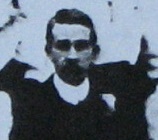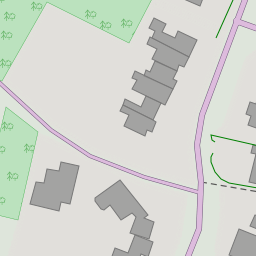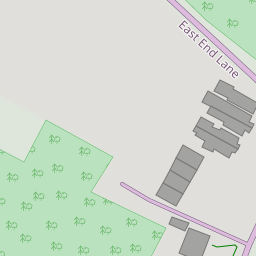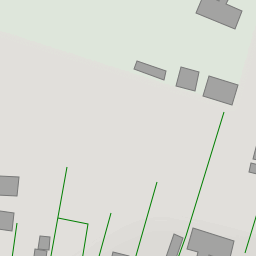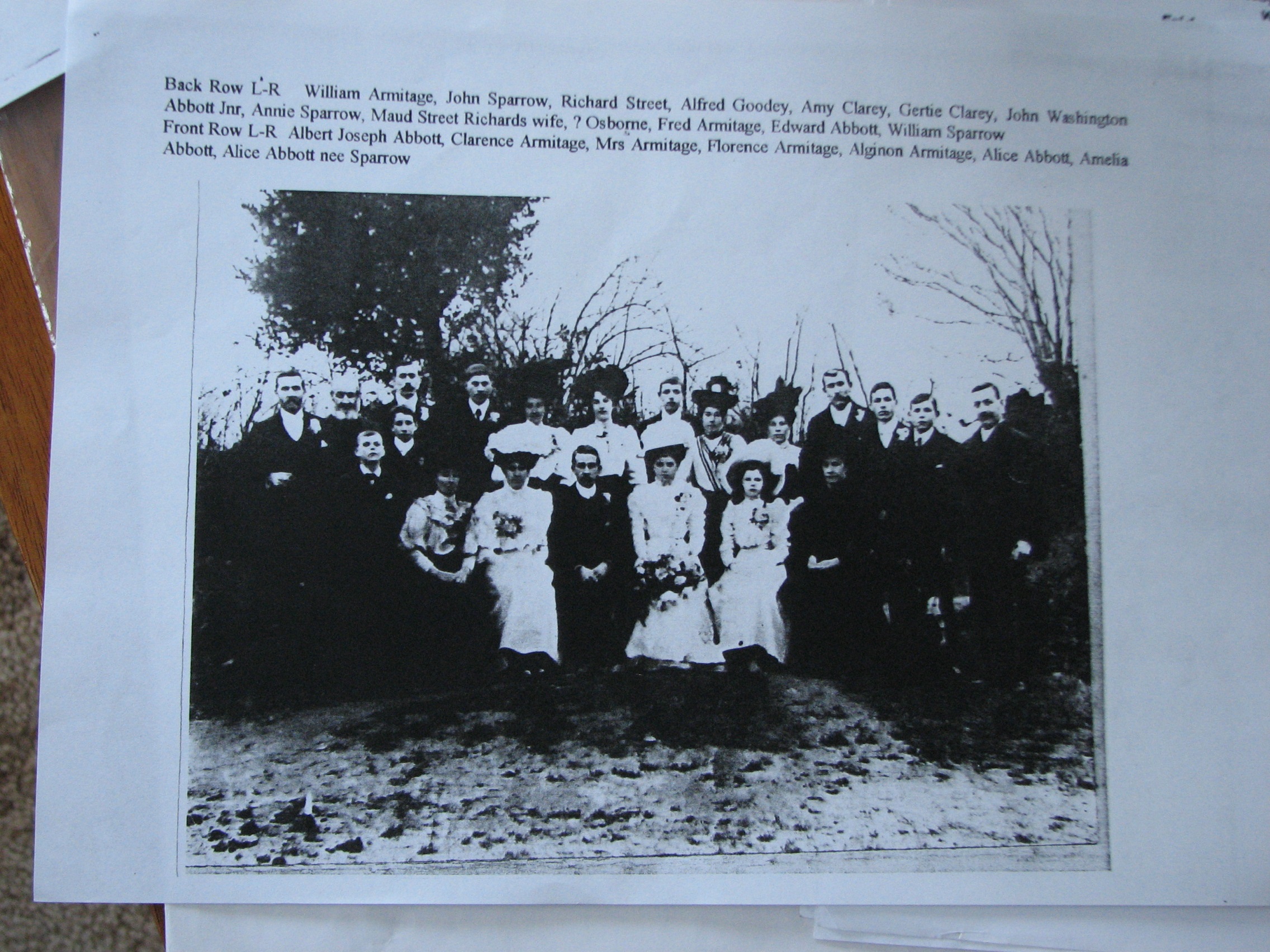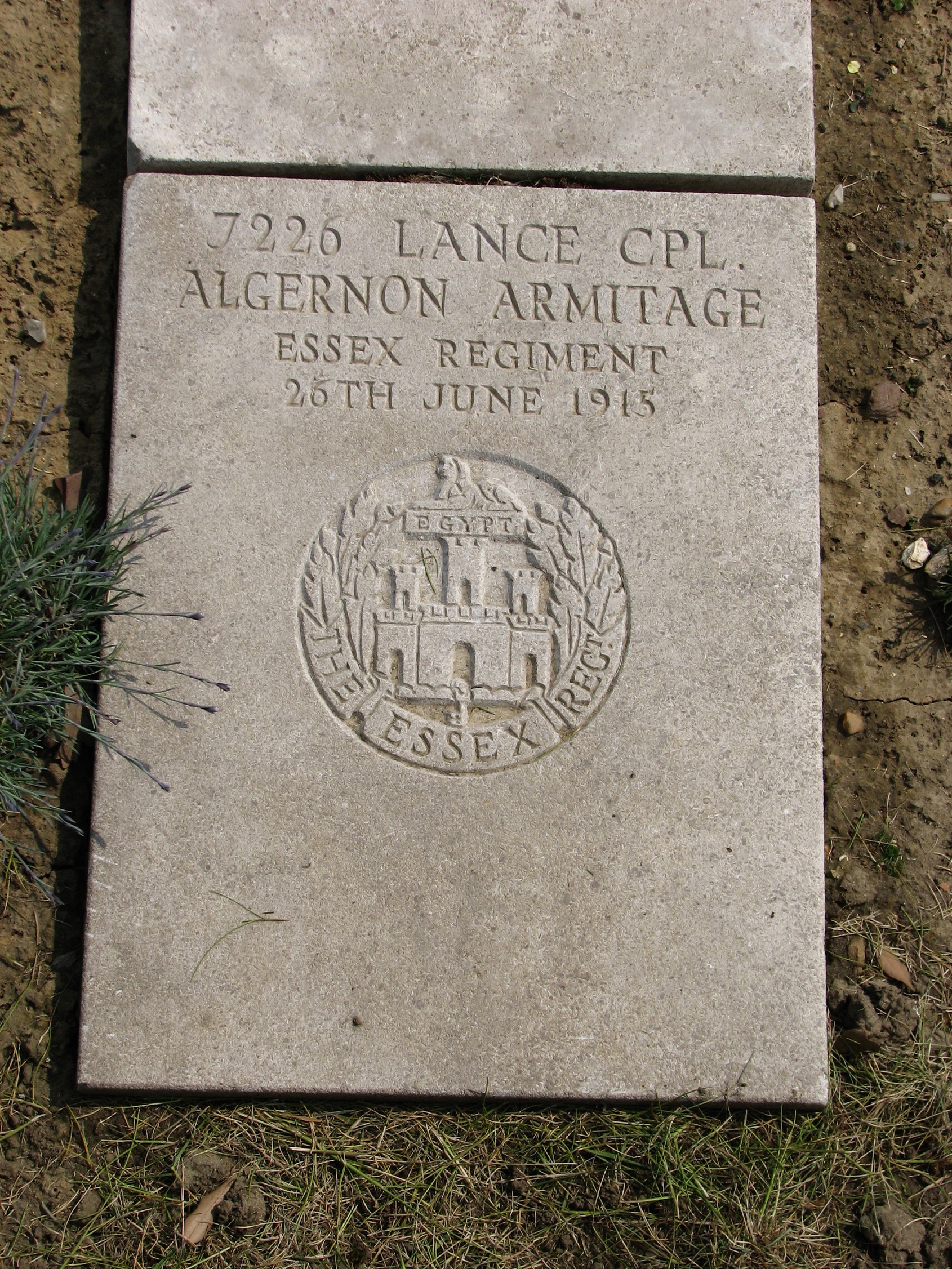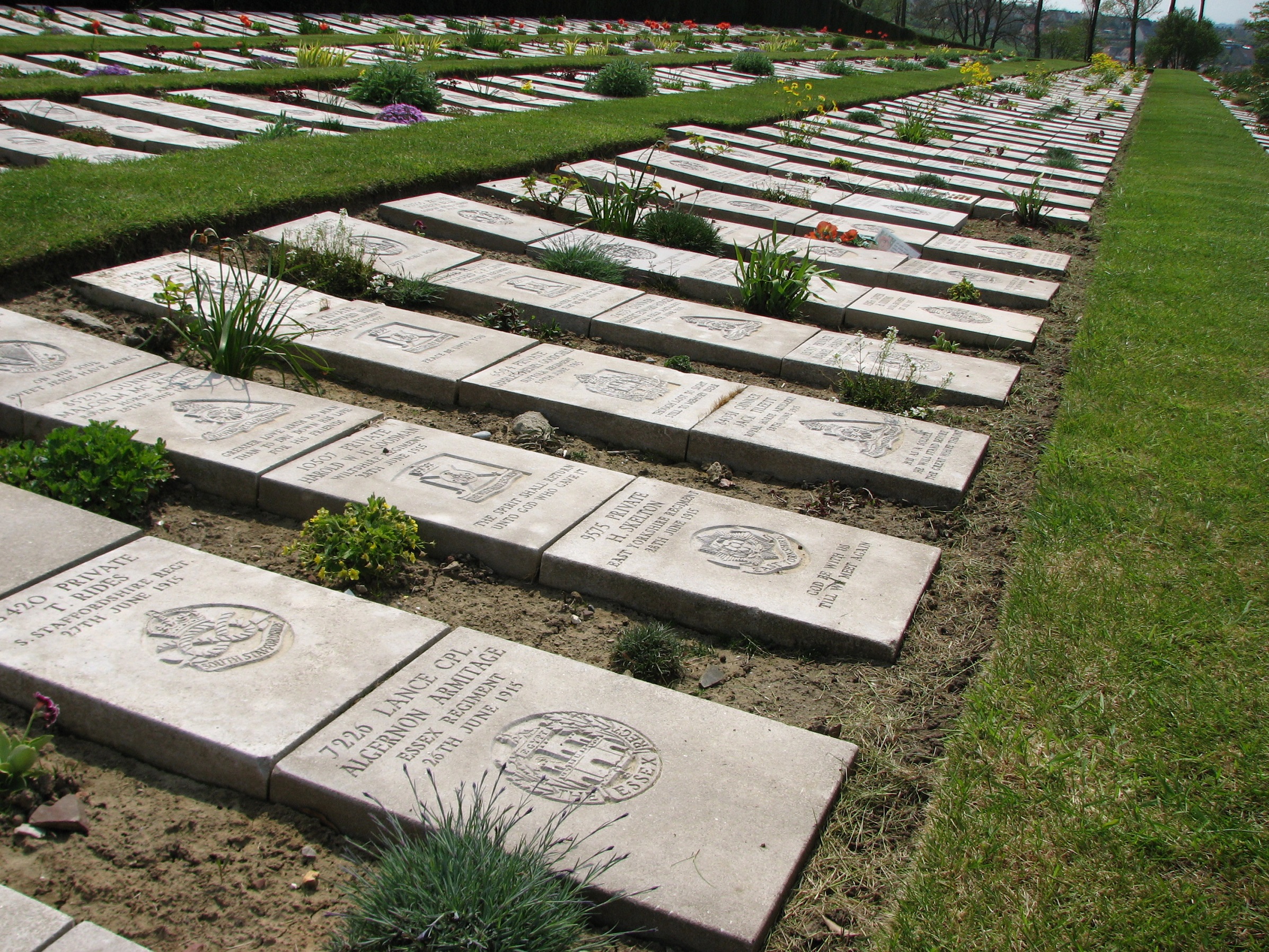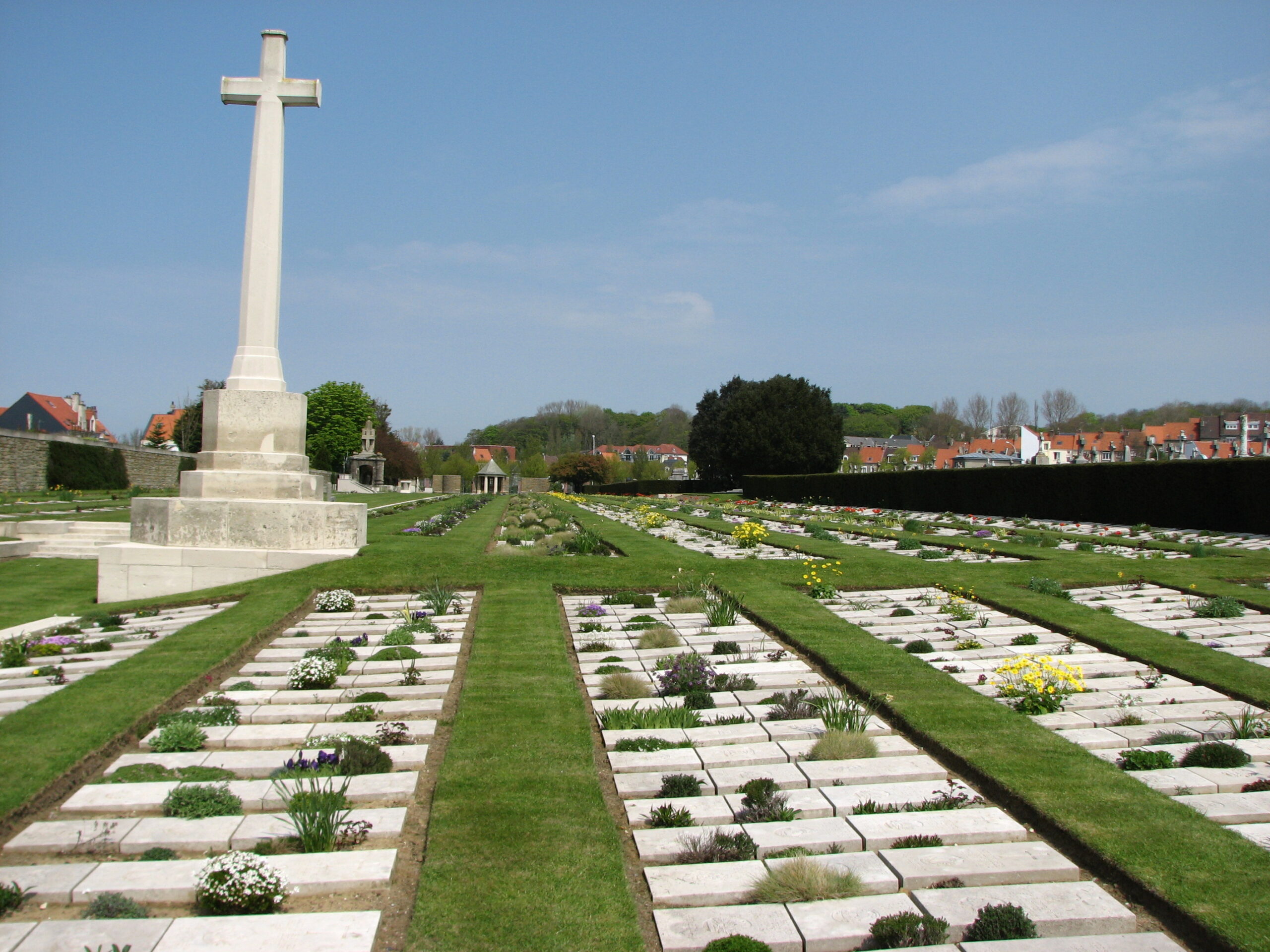Algernon Armitage (1884 - 1915)
An Army Reservist, Algernon was sent to France in September 1914 and served with 2nd Battalion, the Essex Regiment. In July 1915, Algernon died of wounds he had received nearly two months earlier during the 2nd Battle of Ypres, leaving a wife and two children.
- 9
- Died in the Great War
- 51.971771, 1.059552
Details
| Name: | Algernon Henry John James Armitage |
| Service: | British Army |
| Unit: | 2nd Battalion, Essex Regiment |
| Regimental Number: | 7226 |
| Rank: | Lance Corporal |
| Date of Death: | 26th June 1915 |
| Age: | 30 |
| Buried: | Plot VIII, Row B, Grave 51, Boulogne Eastern Cemetery, Boulogne, France |
Family Background and Early Life
Algernon Armitage was born on 19th July 1884, at 64 St Loys Road, Tottenham, London, the first child of William and Jane Armitage.
William Armitage – a Hatter by trade – had married Jane Wilkinson the year before, in the Parish Church at Hackney. William and Jane would go on to have a further five children, though only three lived to adulthood.
It is possible that William Armitage may have had some connection with the British Xylonite Company’s factory at nearby Homerton in east London. Certainly, when the Company opened its new factory in late 1887 – built on 130 acres of land at Cattawade on the Suffolk/Essex border – William was one the first employees. 1 Xylonite was a trade name for Celluloid, an early plastic. The factory at Cattawade is thought to have been the first, purpose built plastics factory in the world.
In order to house many of the workers and their families who had moved from London to work at the new factory, the Company built 60 houses nearby, which have been referred to ever since as New Village. The Armitage family moved into number 47 New Village, but by April of 1901, they had moved to Alice Villa, a semi-detached house situated on the East Bergholt road.
1898 to 1913
In 1898 – shortly after he left School – Algernon started work at the Xylonite Factory.
Unfortunately, like most of those who served in the British Army in the Great War, Algernon’s Service Record does not survive. We do know that he joined the Essex Regiment some years before the War, almost certainly in October 1902. The usual terms of service at that time were for 12 years: 3 years as a full-time Regular, and then – unless the man chose to extend his term as a Regular – he would spend the remaining 9 years in the Army Reserve.
It seems likely that Algernon only signed on for 3 years as a Regular, as by late 1905 he was back working at the Xylonite factory, initially in what was called the Finishing Department, and later in the Xyloidine or Acid Shop. The Acid Shop was where one of the earliest stages in the manufacture of Xylonite took place, and for safety reasons it was situated on the river side of the railway to keep it at a distance from many of the other processes.
On Christmas Day 1908 – her 21st birthday – Algernon married Alice Abbott at St. Michael’s Church in Brantham. Alice had spent most of her life living in Brantham, but by the time of her marriage had moved to East End.
Alice gave birth to their first child on 5th November 1909, a boy who they called John. Algernon and Alice appear to have initially lived in Brantham, but by April of 1911 they had moved to 1 Holly Cottages at East End – just 2 doors away from her family.
Just under 2 years later – on 3rd October 1912 – Algernon and Alice had a second child, this time a girl who they called Gwendoline.
1914/15 – Overseas Service in France and Belgium
It was a condition of service that members of the Army Reserve were to be recalled to the Colours with immediate effect, upon a declaration of war. Consequently, on 4th August 1914 (the day that Britain declared war on Imperial Germany) – all Reservists were ordered to report to their Regimental Depots on the following day. Amongst the East Bergholt men included in this “call-up” were Algernon, Ernest Barber and Edwin Mower, all from East End. 2 Ernest Barber, who had lived at 6 Albert Cottages, served as a Private with the 2nd Battalion of the Suffolk Regiment. He died of wounds in a hospital at Versailles, on 6th October 1914, and is buried in the nearby Les Gonards Cemetery.
Edwin Mower, who had lived at Broom Hill Cottages, also served as a Private with the 2nd Battalion of the Suffolk Regiment. Edwin was killed in action at Sanctuary Wood, near Ypres on 1 October 1915. He is buried in the Sanctuary Wood Cemetery.
Algernon – or Lance Corporal Armitage, to give him his Army rank – was posted to the Essex Regiment’s 2nd Battalion, and disembarked in France on 14th September.
The 2nd Battalion of the Essex Regiment had been in France as part of the British Expeditionary Force (B.E.F.) since 22nd August. Over the next two months, the Battalion was involved in The Great Retreat, the battles of the Marne and the Aisne, along with the series of movements and clashes that have since been referred to as “the Race to the Sea”. 3 The Race to the Sea” was essentially a series of attempts by both sides to turn the open (western) flank of the enemy: It ended in several battles during late October and early November 1914 (the best known being the First Battle of Ypres), after which both sides faced each other in a relatively static, continuous line stretching from the North Sea to the Swiss border. This marked the start of trench warfare, which was to last until the spring of 1918.
It is no longer clear exactly when Algernon actually joined the Battalion “in the field”, but it was most likely before the end of September.
On 21st October 1914 the 2nd Essex were involved in heavy fighting: They successfully managed to halt part of the German advance around the crossroads village of Le Gheer, just inside the Belgian border south of the town of Ypres. In the course of the fighting they suffered 69 casualties.
The Battalion remained in the area between Armentieres and Ploegsteert for the next 6 months. The general routine at this time was for the Battalion to spend 4 days in the trenches, and then spend the next four days in billets, sometimes only a mile or two away and still within easy reach of the German artillery.
The Second Battle of Ypres
On the evening of 22nd April 1915, the Germans launched an offensive to the northwest of Ypres, marking the start of what is now called the Second Battle of Ypres. This offensive saw one of the first uses of poison gas as a weapon, and it enabled the Germans to break through the Allied line.
For a time the situation was critical for the British and French, and troops were hurried to the front in an attempt to stem the German advance. One of the units sent was the 2nd Essex.
The 12th Brigade (of which the 2nd Essex were a part) was ordered to take over the extreme left of the British line, to the left of Shelltrap Farm, north of the village of Wieltje. The Essex entered the trenches on the evening of 30th April; to their left was a French Moroccan brigade.
The Battalion had suffered 20 casualties just moving up to the front, and lost another 29 men on 1st May (including 15 killed) – mainly as a result of the German shellfire.
On the evening of Sunday 2nd May, the Germans employed the use of poison gas again – the Battalion were one of the units manning the front in its path. If this attack had been successful, then Ypres may well have fallen.
Despite heavy casualties, the Battalion held the line with some assistance from other units. The 2nd Essex had suffered 265 casualties, including 23 killed, 67 wounded and 175 missing – many of the latter were subsequently found to have been gassed, and had been evacuated to hospital.
Algernon himself had been wounded in the foot, and gassed. He was evacuated from the front, and was sent to the Canadian Stationary Hospital situated near Boulogne. From there, he wrote a letter to Alice, in which Algernon stated:
“I was wounded in the foot on May 2nd, and also had a dose of asphyxiating gas. The pain of the wound is not so bad, but my chest is still very bad. I seem to want to be always coughing and spitting; it seems to affect you all over the body, and it is very often a job to get breath. The place here is lovely and quiet – right in the country; and after all the noise of the guns and shells I really don’t know what to make of it; they look after me very well indeed.”
Algernon’s wounds may well have been worse than he intimated, and he was moved to the Number 13 General Hospital in Boulogne. There, Algernon succumbed to his wounds on 26th June 1915, aged 30.
Algernon was buried in Boulogne Eastern Cemetery, where he rests to this day.
Postscript
Alice Armitage remarried in 1919, and moved away from East Bergholt. She died in Cambridge, in 1965. 4 In the course of the Great War, Alice Armitage lost her husband, a brother and a brother-in-law; in the Second World War, she also lost a nephew. All are commemorated on the East Bergholt War Memorials in St. Mary’s Church:
Alice’s brother, Albert Joseph Abbott – known as Joseph to his family – lived at 4 Holly Cottages, East End. He served in the 2nd Battalion of the Suffolk Regiment and was killed in action on 16th August 1916, during the Battle of the Somme, aged 19. Joseph has no known grave, and is commemorated on the Thiepval Memorial to the Missing.
Amelia Abbott – Alice’s sister – married George Nunn from Manningtree in 1916. George served in the 11 Battalion of the Royal Fusiliers and died of wounds in hospital in Rouen on 19th February 1917, aged 25. He is buried in the St. Sever Cemetery Extension, in Rouen.
Alice’s nephew – John Washington Abbott, the eldest son of her brother “Jack” – served in the Royal Horse Artillery in the Second World War. John was killed in action in Libya on 15th January 1943, aged 24. He is buried in Tripoli War Cemetery, Libya.
Copyright © Mark Ashmore, 2024
- 9
- Died in the Great War
- 51.971771, 1.059552

